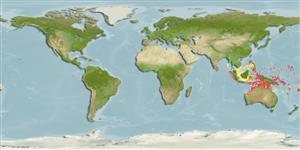>
Perciformes/Serranoidei (Groupers) >
Liopropomatidae (Painted basslets) > Liopropomatinae
Etymology: Liopropoma: Greek, leio = smooth + Greek, pro = in front of + Greek, poma, -atos = cover, operculum (Ref. 45335).
More on authors: Randall & Taylor.
Environment: milieu / climate zone / depth range / distribution range
Écologie
marin récifal; profondeur 18 - 50 m (Ref. 48635). Tropical; 15°N - 20°S
Western Pacific: Philippines, Palau, Papua New Guinea, the Solomons, Fiji, and Osprey Reef in the Coral Sea; also in Rowley Shoals in the eastern Indian Ocean.
Taille / Poids / Âge
Maturity: Lm ? range ? - ? cm
Max length : 8.0 cm TL mâle / non sexé; (Ref. 2334)
Épines dorsales (Total) : 8; Rayons mous dorsaux (Total) : 11 - 12; Épines anales: 3; Rayons mous anaux: 8. Easily identified by the unusual coloration. The yellow is obvious but the red looks grey when seen in natural light (Ref. 48635). Differs from L. tonstrinum by having numerous red pinstripes on its sides, a less pronounced white lateral stripe, and a serrate posterior preopercular margin (Ref. 37816).
A benthic species (Ref. 75154), generally taken from caves (Ref. 1602) with rotenone used for collection (Ref. 1602). Also a ledge dweller and secretive (Ref 90102).
Life cycle and mating behavior
Maturité | Reproduction | Frai | Œufs | Fécondité | Larves
Myers, R.F., 1991. Micronesian reef fishes. Second Ed. Coral Graphics, Barrigada, Guam. 298 p. (Ref. 1602)
Statut dans la liste rouge de l'IUCN (Ref. 130435: Version 2024-2)
Menace pour l'homme
Harmless
Utilisations par l'homme
Outils
Articles particuliers
Télécharger en XML
Sources Internet
Estimates based on models
Preferred temperature (Ref.
123201): 26.2 - 28.5, mean 27.2 °C (based on 56 cells).
Phylogenetic diversity index (Ref.
82804): PD
50 = 0.5000 [Uniqueness, from 0.5 = low to 2.0 = high].
Bayesian length-weight: a=0.00389 (0.00180 - 0.00842), b=3.12 (2.94 - 3.30), in cm total length, based on all LWR estimates for this body shape (Ref.
93245).
Niveau trophique (Ref.
69278): 3.6 ±0.6 se; based on size and trophs of closest relatives
Fishing Vulnerability (Ref.
59153): Low vulnerability (10 of 100).
